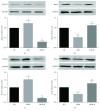Inhibition of HDAC3 Ameliorates Cerebral Ischemia Reperfusion Injury in Diabetic Mice In Vivo and In Vitro
- PMID: 30906786
- PMCID: PMC6393870
- DOI: 10.1155/2019/8520856
Inhibition of HDAC3 Ameliorates Cerebral Ischemia Reperfusion Injury in Diabetic Mice In Vivo and In Vitro
Abstract
Background: A substantial increase in histone deacetylase 3 (HDAC3) expression is implicated in the pathological process of diabetes and stroke. However, it is unclear whether HDAC3 plays an important role in diabetes complicated with stroke. We aimed to explore the role and the potential mechanisms of HDAC3 in cerebral ischemia/reperfusion (I/R) injury in diabetic state.
Methods: Diabetic mice were subjected to 1 h ischemia, followed by 24 h reperfusion. PC12 cells were exposed to high glucose for 24 h, followed by 3 h of hypoxia and 6 h of reoxygenation (H/R). Diabetic mice received RGFP966 (the specific HDAC3 inhibitor) or vehicle 30 minutes before the middle cerebral artery occlusion (MCAO), and high glucose-incubated PC12 cells were pretreated with RGFP966 or vehicle 6 h before H/R.
Results: HDAC3 inhibition reduced the cerebral infarct volume, ameliorated pathological changes, improved the cell viability and cytotoxicity, alleviated apoptosis, attenuated oxidative stress, and enhanced autophagy in cerebral I/R injury model in diabetic state in vivo and in vitro. Furthermore, we found that the expression of HDAC3 was remarkably amplified, and the Bmal1 expression was notably decreased in diabetic mice with cerebral I/R, whereas this phenomenon was obviously reversed by RGFP966 pretreatment.
Conclusions: These results suggested that the HDAC3 was involved in the pathological process of the complex disease of diabetic stroke. Suppression of HDAC3 exerted protective effects against cerebral I/R injury in diabetic state in vivo and in vitro via the modulation of oxidative stress, apoptosis, and autophagy, which might be mediated by the upregulation of Bmal1.
Figures





Similar articles
-
Ibrutinib ameliorates cerebral ischemia/reperfusion injury through autophagy activation and PI3K/Akt/mTOR signaling pathway in diabetic mice.Bioengineered. 2021 Dec;12(1):7432-7445. doi: 10.1080/21655979.2021.1974810. Bioengineered. 2021. PMID: 34605340 Free PMC article.
-
Neuroprotective Effects of Radix Scrophulariae on Cerebral Ischemia and Reperfusion Injury via MAPK Pathways.Molecules. 2018 Sep 19;23(9):2401. doi: 10.3390/molecules23092401. Molecules. 2018. PMID: 30235876 Free PMC article.
-
The Protective Role of Bmal1-Regulated Autophagy Mediated by HDAC3/SIRT1 Pathway in Myocardial Ischemia/Reperfusion Injury of Diabetic Rats.Cardiovasc Drugs Ther. 2022 Apr;36(2):229-243. doi: 10.1007/s10557-021-07159-1. Epub 2021 Feb 23. Cardiovasc Drugs Ther. 2022. PMID: 33620678
-
Reperfusion and neurovascular dysfunction in stroke: from basic mechanisms to potential strategies for neuroprotection.Mol Neurobiol. 2010 Jun;41(2-3):172-9. doi: 10.1007/s12035-010-8102-z. Epub 2010 Feb 17. Mol Neurobiol. 2010. PMID: 20157789 Free PMC article. Review.
-
Novel protective effects of histone deacetylase inhibition on stroke and white matter ischemic injury.Neurotherapeutics. 2013 Oct;10(4):798-807. doi: 10.1007/s13311-013-0201-x. Neurotherapeutics. 2013. PMID: 23881453 Free PMC article. Review.
Cited by
-
Updating a Strategy for Histone Deacetylases and Its Inhibitors in the Potential Treatment of Cerebral Ischemic Stroke.Dis Markers. 2020 Sep 5;2020:8820803. doi: 10.1155/2020/8820803. eCollection 2020. Dis Markers. 2020. PMID: 32963637 Free PMC article. Review.
-
The Therapeutic Effects of Treadmill Exercise on Osteoarthritis in Rats by Inhibiting the HDAC3/NF-KappaB Pathway in vivo and in vitro.Front Physiol. 2019 Aug 20;10:1060. doi: 10.3389/fphys.2019.01060. eCollection 2019. Front Physiol. 2019. PMID: 31481898 Free PMC article.
-
The Neuroprotective Effect of the HDAC2/3 Inhibitor MI192 on the Penumbra After Photothrombotic Stroke in the Mouse Brain.Mol Neurobiol. 2020 Jan;57(1):239-248. doi: 10.1007/s12035-019-01773-9. Epub 2019 Sep 11. Mol Neurobiol. 2020. PMID: 31512115
-
Low-intensity pulsed ultrasound of different intensities differently affects myocardial ischemia/reperfusion injury by modulating cardiac oxidative stress and inflammatory reaction.Front Immunol. 2023 Sep 7;14:1248056. doi: 10.3389/fimmu.2023.1248056. eCollection 2023. Front Immunol. 2023. PMID: 37744362 Free PMC article.
-
Selenium attenuates ischemia/reperfusion injury‑induced damage to the blood‑brain barrier in hyperglycemia through PI3K/AKT/mTOR pathway‑mediated autophagy inhibition.Int J Mol Med. 2021 Sep;48(3):178. doi: 10.3892/ijmm.2021.5011. Epub 2021 Jul 23. Int J Mol Med. 2021. PMID: 34296284 Free PMC article.
References
MeSH terms
Substances
LinkOut - more resources
Full Text Sources

